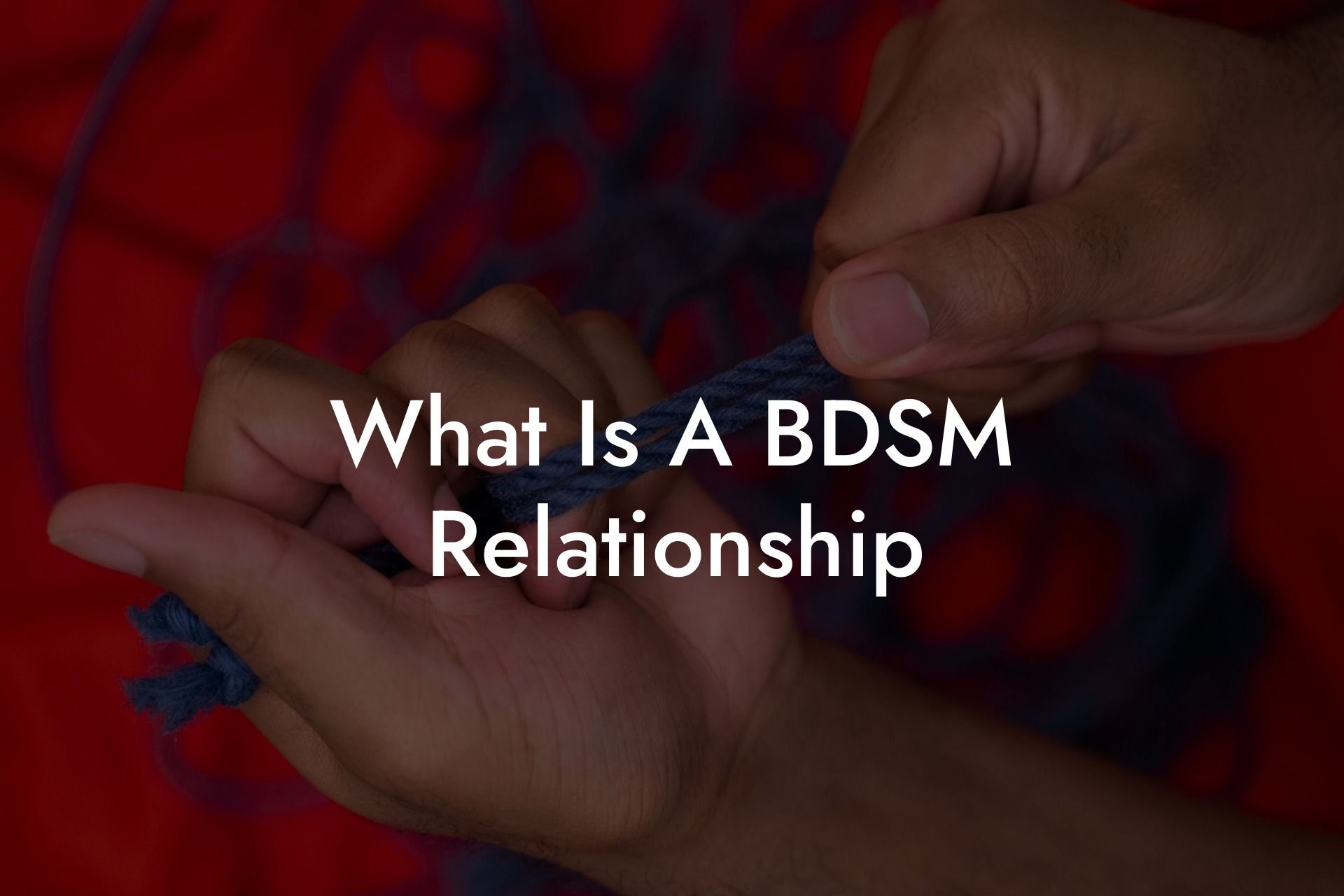What Is A BDSM Relationship

BDSM relationships are dynamic partnerships that blend the elements of power exchange, trust, and communication into a unique form of intimacy. Unlike conventional relationships that may focus solely on romance or physical attraction, BDSM relationships center around negotiated roles, mutual respect, and the consensual exploration of desires. Whether you’re curious about how BDSM relationships work or you’re already part of the lifestyle and seeking to deepen your connection, this comprehensive guide will explore every aspect of what a BDSM relationship entails, from the psychological and emotional components to practical tips and real-life experiences.
Quick Links to Useful Sections
- Understanding BDSM Relationships
- Defining a BDSM Relationship
- The Core Components of a BDSM Relationship
- Consent and Communication
- Trust and Vulnerability
- Roles and Power Exchange
- Navigating the Emotional Dynamics
- Emotional Intimacy and Connection
- Handling Conflict and Miscommunication
- Practical Aspects of a BDSM Relationship
- Pre-Scene Negotiation and Planning
- Integrating BDSM Into Everyday Life
- The Benefits of a BDSM Relationship
- Empowerment and Self-Discovery
- Enhanced Communication and Trust
- Creative and Intense Sexual Experiences
- Challenges in a BDSM Relationship
- Balancing Intensity and Everyday Life
- Managing Expectations and Miscommunication
- Dealing with External Stigma
- Real-Life Experiences and Inspirations
- Case Study: Emma’s Empowering Journey
- Case Study: Ryan and Alex’s Dynamic Connection
- Expert Insights: Advice from the BDSM Community
- Words of Wisdom from the Field
- FAQ: Your “What Is a BDSM Relationship” Questions Answered
Understanding BDSM Relationships
Defining a BDSM Relationship
At its core, a BDSM relationship is a consensual partnership where power dynamics play a central role. This can include dominance and submission (D/s), bondage and discipline (B/D), and elements of sadism and masochism (S/M). Unlike traditional relationships, BDSM relationships often involve explicit negotiations about roles, boundaries, and expectations. This clarity not only ensures that each partner’s desires are met but also forms the foundation for trust and emotional security.
A key feature of BDSM relationships is that all activities are fully consensual. Both partners actively participate in establishing what is acceptable and safe, often using safe words, signals, and detailed pre-scene negotiations. This openness fosters an environment where vulnerability is embraced, and both emotional and physical needs are addressed.
The Core Components of a BDSM Relationship
Consent and Communication
Consent is the cornerstone of any BDSM relationship. Every activity, from a light spanking to intricate rope bondage, is negotiated in advance, ensuring that all participants have a clear understanding of their roles and limits. Communication goes hand in hand with consent; partners engage in continuous dialogue before, during, and after scenes to ensure that boundaries are respected and that both parties feel secure.
Effective communication allows partners to discuss their desires, negotiate safe words, and plan aftercare routines. It’s this transparent exchange that transforms potentially risky play into a mutually empowering experience.
Trust and Vulnerability
Trust is essential in a BDSM relationship because it involves a significant level of vulnerability. Submitting to a partner or taking control in a scene requires a deep trust that your boundaries will be respected and that your well-being will always be the priority. This trust is built over time through consistent, honest communication and the careful negotiation of limits.
For many, the ability to be vulnerable is incredibly liberating. It allows individuals to shed societal expectations and express parts of themselves that are often hidden. In a BDSM relationship, vulnerability isn’t seen as a weakness, it’s a source of strength and intimacy.
Roles and Power Exchange
BDSM relationships are known for their focus on power dynamics, which can take many forms. Some relationships have clearly defined dominant and submissive roles, while others are more fluid, allowing partners to switch roles or explore different aspects of power exchange at different times. This flexibility means that a BDSM relationship can be as varied as the individuals involved.
The roles in a BDSM relationship are typically negotiated and can include elements of discipline, service, and control. For example, a dominant might establish rules or rituals that a submissive follows, while a submissive might take pride in their willingness to surrender control in a way that feels both empowering and safe.
Looking for the best BDSM & Kink OnlyFans content creators? Check out these UNBELIEVABLE OnlyFans Creators:
-
-
-
- Best Slutty Asian Cosplay OnlyFans → 🥵 Shadow Kitsune → View Pictures & Videos
- Best Solo & Dildo Play OnlyFans Creator → 🌹 Lexy , Your Fifty Shades of Fantasy 🌹 → View Pictures & Videos
- Best Filthy Teen Brat & Girlfriend Experience OnlyFans Creator → 💋 Alexa – Your Shy & Wild Girlfriend 💋 → View Pictures & Videos
- Best Slutty Submissive British Blonde OnlyFans Creator → Sofia 🧚 → View Pictures & Videos
- Best Anal, Sexting & Dick Rating OnlyFans Creator → Sofia💕 → View Pictures & Videos
- Best Hot Asian & Latina Mixed OnlyFans Creator → 🍑 Miso Lexii - Half Latina / Half Asian 👅 → View Pictures & Videos
-
-
Navigating the Emotional Dynamics
Emotional Intimacy and Connection
Despite the often intense physical play, BDSM relationships are deeply emotional. The explicit communication and negotiation required in these relationships help build a level of intimacy that is both profound and enduring. Partners learn to understand each other’s triggers, boundaries, and desires on a granular level, leading to a richer emotional connection.
The process of engaging in power exchange, while managing vulnerability, creates an environment where genuine intimacy can flourish. This connection is often reinforced by aftercare sessions, where partners come together to process the emotional and physical intensity of a scene.
Handling Conflict and Miscommunication
Like any relationship, BDSM dynamics can experience conflict or miscommunication. However, because BDSM relationships require such explicit negotiation of roles and boundaries, they often develop strong mechanisms for resolving issues. Regular debriefing after scenes, honest feedback, and a willingness to renegotiate boundaries help prevent misunderstandings and ensure that both partners continue to feel safe and respected.
It’s important to remember that disagreements or moments of discomfort are opportunities for growth. Addressing these issues openly can lead to deeper understanding and a more resilient relationship.
Practical Aspects of a BDSM Relationship
Pre-Scene Negotiation and Planning
Before engaging in any play, partners typically have an in-depth conversation about their desires, limits, and expectations. This pre-scene negotiation is a ritual in itself, setting the stage for safe and satisfying experiences. Topics discussed might include:
- Activities and Limits: What specific activities are on the table, and what are your hard limits?
- Safe Words and Signals: Agreeing on a method to pause or stop the scene if needed.
- Roles and Expectations: Clarifying who will take on the dominant or submissive role and how these roles may switch during the scene.
- Aftercare: Outlining the plan for physical and emotional recovery following a scene.
This careful planning is not only a safety measure, it also deepens the connection between partners by ensuring that each person’s needs and boundaries are respected.
Integrating BDSM Into Everyday Life
While BDSM play is often associated with dedicated scenes, many couples integrate elements of kink into their daily routines. This can include:
- Daily Rituals: Small, negotiated routines that reinforce the power dynamic, such as specific greetings or tasks.
- Regular Check-Ins: Ongoing conversations about desires, limits, and how the relationship is evolving.
- Public Expressions: Some couples choose to incorporate subtle BDSM elements into their public lives, such as wearing discreet symbols of their dynamic.
These integrations help maintain the connection between partners, ensuring that the intensity of BDSM scenes complements rather than replaces everyday intimacy.
The Benefits of a BDSM Relationship
Empowerment and Self-Discovery
Many individuals find that BDSM relationships offer a path to profound personal empowerment. By exploring their desires in a safe, consensual environment, partners can confront and embrace aspects of themselves that might otherwise remain hidden. The explicit negotiation of power and vulnerability encourages self-reflection and growth, leading to increased self-confidence and a more authentic expression of identity.
Enhanced Communication and Trust
The necessity of clear, continuous communication in BDSM relationships builds a strong foundation of trust. Partners learn to articulate their needs, set boundaries, and adjust to each other’s feedback in real time. This level of openness not only improves the quality of the scenes but also enriches the overall relationship, fostering a deeper emotional bond.
Creative and Intense Sexual Experiences
BDSM relationships open up a world of creative possibilities that go beyond traditional sex. From intricate role-play to elaborate bondage scenes, the intentional exploration of power dynamics can lead to experiences that are both physically intense and emotionally fulfilling. This creativity in sexual expression often leads to a more satisfying and dynamic intimate life.
Challenges in a BDSM Relationship
Balancing Intensity and Everyday Life
One of the primary challenges in a BDSM relationship is balancing the intensity of kink scenes with the demands of everyday life. It requires ongoing effort to ensure that the excitement of play does not overshadow the need for regular emotional connection and stability.
Couples must work together to integrate their BDSM dynamic into their daily routines without compromising either aspect. Regular check-ins and clear communication are essential for maintaining this balance.
Managing Expectations and Miscommunication
With the added complexity of negotiated power dynamics, there is always a risk of miscommunication or unmet expectations. Clear, honest dialogue is vital, as is a willingness to renegotiate boundaries as the relationship evolves. Addressing any issues promptly and constructively is key to preventing long-term conflicts.
Dealing with External Stigma
Unfortunately, BDSM relationships can sometimes be met with societal stigma or misunderstanding. Navigating these external pressures requires confidence, self-acceptance, and often the support of a like-minded community. Embracing your identity and educating others about consensual kink can help mitigate these challenges.
Real-Life Experiences and Inspirations
Case Study: Emma’s Empowering Journey
Emma, a longtime submissive in a BDSM relationship, describes how the explicit negotiations and continuous communication in her relationship have led to deeper intimacy and self-empowerment. By openly discussing her boundaries and desires with her Dominant partner, Emma discovered that BDSM allowed her to embrace her vulnerability while feeling truly valued and respected.
Looking for the best BDSM & Kink OnlyFans content creators? Check out these UNBELIEVABLE OnlyFans Creators:
-
-
-
- Best Slutty Asian Cosplay OnlyFans → 🥵 Shadow Kitsune → View Pictures & Videos
- Best Solo & Dildo Play OnlyFans Creator → 🌹 Lexy , Your Fifty Shades of Fantasy 🌹 → View Pictures & Videos
- Best Filthy Teen Brat & Girlfriend Experience OnlyFans Creator → 💋 Alexa – Your Shy & Wild Girlfriend 💋 → View Pictures & Videos
- Best Slutty Submissive British Blonde OnlyFans Creator → Sofia 🧚 → View Pictures & Videos
- Best Anal, Sexting & Dick Rating OnlyFans Creator → Sofia💕 → View Pictures & Videos
- Best Hot Asian & Latina Mixed OnlyFans Creator → 🍑 Miso Lexii - Half Latina / Half Asian 👅 → View Pictures & Videos
-
-
Emma’s journey illustrates how the unique aspects of a BDSM relationship, when managed with care, can lead to transformative personal growth and an exceptionally fulfilling partnership.
Case Study: Ryan and Alex’s Dynamic Connection
Ryan and Alex have built a BDSM relationship that seamlessly integrates intense scenes with everyday affection. They engage in regular negotiations, attend workshops together, and even incorporate small, meaningful rituals into their daily routine. Their relationship exemplifies how clear communication, trust, and mutual support can create a vibrant and dynamic connection that honors both the kinky and conventional aspects of their intimacy.
Their story is a testament to the benefits of combining education, creativity, and emotional depth in a BDSM relationship.
Expert Insights: Advice from the BDSM Community
Words of Wisdom from the Field
Veteran Dominant Marcus Steele advises, “A successful BDSM relationship is built on a foundation of clear communication, mutual respect, and a willingness to explore all aspects of your desires. The process of negotiating and engaging in power exchange can transform not only your intimate life but your entire sense of self.”
BDSM counselor Fiona Rivera adds, “The beauty of BDSM relationships is that they allow for a profound connection that goes beyond the physical. By embracing vulnerability and negotiating your needs openly, you create a dynamic that is both empowering and deeply nurturing.”
FAQ: Your “What Is a BDSM Relationship” Questions Answered
1. What is a BDSM relationship?
A BDSM relationship is a consensual partnership where power exchange, kink, and negotiated sexual dynamics play a central role. It involves explicit communication about roles, boundaries, and desires to ensure that all activities are safe and mutually satisfying.
2. How does a BDSM relationship differ from a traditional relationship?
Unlike traditional relationships that may focus primarily on romance or conventional intimacy, BDSM relationships place a strong emphasis on negotiated power dynamics, explicit consent, and the exploration of kink. This often involves detailed discussions about limits, roles, and aftercare.
3. What are the core components of a BDSM relationship?
The core components include consent, communication, trust, negotiated boundaries, and a focus on power exchange. Partners openly discuss their desires and limits and establish protocols for safe, consensual play.
4. Can BDSM relationships include both vanilla and kink elements?
Yes, many BDSM relationships blend traditional intimacy with kink. Couples may engage in conventional sex as well as negotiated BDSM scenes, creating a balanced dynamic that caters to a full spectrum of desires.
5. How important is negotiation in a BDSM relationship?
Negotiation is crucial. It ensures that all parties are aware of and agree to the boundaries, roles, and activities involved, which helps build trust and prevents misunderstandings during play.
6. What role does aftercare play in a BDSM relationship?
Aftercare is vital, it involves the physical and emotional care provided after a scene. This process helps both partners recover, reinforces trust, and ensures that the intense experiences are processed in a supportive manner.
7. Can roles in a BDSM relationship change over time?
Absolutely. Many BDSM relationships are fluid, with partners sometimes switching between dominant and submissive roles based on their mood, the situation, or personal growth. Open communication ensures that these changes are negotiated and consensual.
8. Is a BDSM relationship only for those who are deeply into kink?
Not at all. BDSM relationships can vary widely in intensity and style. Some couples may incorporate only mild kink elements, while others engage in more intense power exchange. The key is that all activities are consensual and tailored to the partners’ preferences.
9. How do partners maintain trust in a BDSM relationship?
Trust is maintained through clear, ongoing communication, strict adherence to negotiated boundaries, and regular check-ins both during and outside of play. Consistent aftercare and transparency further strengthen this trust.
10. Where can I learn more about BDSM relationships?
Reputable resources include books like "SM 101: A Realistic Introduction," online communities such as FetLife and Reddit’s r/BDSM, podcasts like "Kink Academy," and local workshops that focus on the dynamics of BDSM relationships.
Resources and Community Support: Your Next Steps in Exploring BDSM Relationships
- FetLife: Join this online platform to connect with others in the BDSM community, share experiences, and learn about local events and workshops.
- Reddit: Engage with subreddits like r/BDSM to gain insights and ask questions about BDSM relationships.
- BDSM Literature: Read books such as "SM 101: A Realistic Introduction" to build a strong foundation in safe, consensual BDSM practices.
- Podcasts and Videos: Listen to "Kink Academy" and watch tutorials to get expert advice on navigating BDSM dynamics.
- Workshops and Local Events: Attend classes and social gatherings to connect with experienced kinksters and gain hands-on knowledge.
A BDSM relationship is a journey of exploration, trust, and mutual growth. By prioritizing open communication, clear boundaries, and continuous learning, you can create a dynamic partnership that enriches both your intimate life and personal well-being. Embrace the adventure, educate yourself, and build connections that empower you to express your true self.
Looking for the best BDSM & Kink OnlyFans content creators? Check out these UNBELIEVABLE OnlyFans Creators:
-
-
-
- Best Slutty Asian Cosplay OnlyFans → 🥵 Shadow Kitsune → View Pictures & Videos
- Best Solo & Dildo Play OnlyFans Creator → 🌹 Lexy , Your Fifty Shades of Fantasy 🌹 → View Pictures & Videos
- Best Filthy Teen Brat & Girlfriend Experience OnlyFans Creator → 💋 Alexa – Your Shy & Wild Girlfriend 💋 → View Pictures & Videos
- Best Slutty Submissive British Blonde OnlyFans Creator → Sofia 🧚 → View Pictures & Videos
- Best Anal, Sexting & Dick Rating OnlyFans Creator → Sofia💕 → View Pictures & Videos
- Best Hot Asian & Latina Mixed OnlyFans Creator → 🍑 Miso Lexii - Half Latina / Half Asian 👅 → View Pictures & Videos
-
-

 Fuck Each Other Not The Planet Unisex
Fuck Each Other Not The Planet Unisex Wear My Kink
Wear My Kink